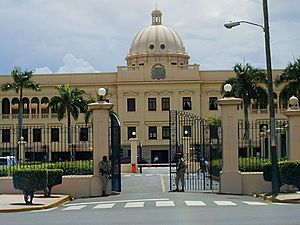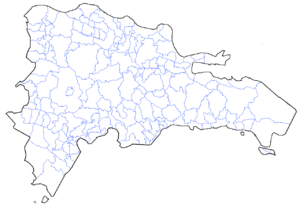Government of the Dominican Republic facts for kids
The Dominican Republic has a special way of governing itself, based on its Constitution. It's called a presidential democratic republic. It's a republic because its main leader, the President, is chosen by the people, not born into a royal family like a king or queen. It's presidential because the President is both the head of the country and the head of the government. This is different from some countries that have a Prime Minister. And it's democratic because people get to vote for their President, Vice-President, and the members of Congress.
Contents
How the National Government Works
The Constitution of the Dominican Republic explains that the national government has three main parts, like three separate teams working together. These teams are called branches, and they each have their own special jobs. They are the executive branch, the legislative branch, and the judicial branch. Even though they work together, they are independent, meaning one branch doesn't control the others. This is called the separation of powers.
The Executive Branch
The executive branch is like the country's management team. Its main job is to make sure the laws are followed and to run the country day-to-day. The people vote for a President and a Vice-President. The President is the leader of this branch and also the head of the country's Armed Forces.
The President decides if new laws passed by the legislative branch will actually become laws. The President can also issue "decrees," which are like special rules to help govern the country. Many different departments, led by people called Secretaries of State, help the President manage everything. For example, the Secretary of State of Agriculture helps with farming and food. A President can serve for two terms, each lasting four years, which means a total of eight years.
The Legislative Branch
The legislative branch is the part of the government that creates the laws. It's made up of a group called Congress, which meets in Santo Domingo, the capital city. Congress is split into two main groups, or "chambers."
One group is the Chamber of Deputies (in Spanish, Cámara de Diputados). The Deputies are elected by voters from different areas called provinces. The number of Deputies a province has depends on how many people live there. More people means more Deputies, but every province has at least two. Deputies serve for four years. In the period from 2006 to 2010, there were 178 Deputies.
The other group is the Senate (Senado). In the Senate, each province gets the same number of representatives: one Senator. Senators also serve for four years. There are 32 Senators in total, one for each province and one for the National District, where the capital city is located.
The Judicial Branch
The judicial branch is the part of the government that makes sure laws are fair and followed correctly. It also explains what the laws mean if there's any confusion. This branch includes the Supreme Court and many other smaller courts. If the Supreme Court decides that a law goes against the Constitution, then that law can no longer be used.
The Supreme Court has at least 11 judges. The main judge is called the President of the Supreme Court. A Supreme Court Justice serves until they either pass away or decide to step down. The Supreme Court oversees all the other courts throughout the country.
Local Government: Provinces and Municipalities
Besides the national government, there are also governments for smaller areas like provinces and municipalities.
Each province has a governor. The only place without a governor is the National District, which is where the capital city is. These governors represent the President of the Republic in their provinces.
Every province is divided into smaller areas called municipalities (in Spanish, municipios). The Distrito Nacional (National District) has only one municipality, which is Santo Domingo.
Municipalities
In municipalities, there are two main parts of government: the executive and the legislative. The people who live in the municipality vote for these leaders every four years.
The Mayor (Síndico) is the head of the executive branch in a municipality. The Municipal Council (Ayuntamiento) is the legislative branch, which makes local rules.
The rural parts of a municipality are divided into "sections" (Secciones). Each section has a person who represents the municipal government there. As of June 20, 2006, the Dominican Republic had 154 municipalities.
Municipal Districts
A municipality can also have one or more municipal districts (distrito municipal). A special group called a municipal council (Junta Municipal) is chosen for these districts. However, the people living in the municipal district don't vote for this council directly. Instead, the municipal council of the main municipality chooses them. As of June 20, 2006, there were 202 municipal districts in the Dominican Republic.
See also
 In Spanish: Política de la República Dominicana para niños
In Spanish: Política de la República Dominicana para niños



